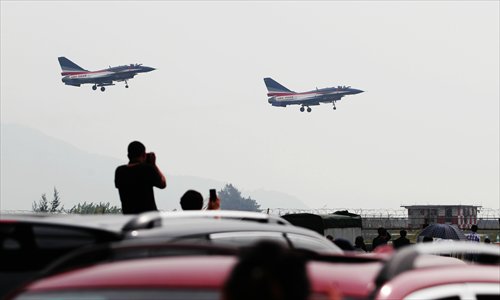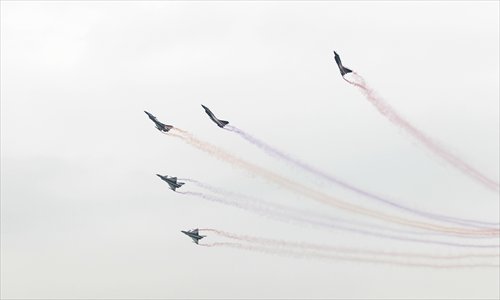PLA female pilots aspire to become China’s next generation of astronauts
China's drive to correct the gender imbalance in the military is beginning to bear fruit. Every time a female military hero appears they draw great attention from the public, such as the female soldiers marching in formation for the National Day parade and the country's first female astronaut Liu Yang who flew on the Shenzhou space missions. The air force has been training female pilots for more than six decades, however, women piloting fighter jets is a recent development.

Members of the Bayi Aerobatic Team back on the ground after their performance during the 10th China International Aviation and Aerospace Exhibition in Zhuhai, Guangdong Province on November 16. Photo: Cui Meng/GT
In 2009, He Xiaoli led a formation of fighter jets that flew over Tiananmen Square in Beijing during a grand military parade that was put on to celebrate the 60th anniversary of the founding of the People's Republic of China. The team of female pilots she was part of immediately became a national sensation.
Five years on, female fighter jet pilot He appeared in public once again, this time in a more dazzling way. She and her team piloted J-10 fighter planes and performed acrobatics in the air.
At the 10th China International Aviation and Aerospace Exhibition held in Zhuhai, Guangdong Province earlier this month, four female pilots, including He, performed as part of the Bayi Aerobatic Team, under the People's Liberation Army's air force.
The performing team of six J-10 planes, China's third-generation fighter jet, put on a spectacular show, flying in close formation, diving, rolling and corkscrewing to thunderous applause from the spectators.
The four female pilots, He Xiaoli, Tao Jiali, Yu Xu and Sheng Yifei, have flown four types of planes, including second- and third-generation Chinese fighter jets, as well as their specially adapted performance planes.
The Bayi Aerobatic Team selects pilots according to incredibly strict criteria, with most of the members having accumulated more than 1,000 flying hours and being above the First-Grade level. These high standards mean that only the best pilots in China can make it on to the team. The Bayi team's performance at the Zhuhai air show was a rare chance for the four female pilots to take the limelight, as they are only Second-Grade pilots, with, on average, 800 flying hours under their belts.
This year the Bayi team displayed newly designed maneuvers including a six-plane corkscrew formation and one which features three-plane crisscrossing, which poses huge challenges for the pilots, especially for the newer female members.
Their performance won recognition from their military superiors. "Don't underestimate these girls, they fly smoothly," joked Zhao Kangping, commander of the division. Zhao refers to them as "air force babes."
Military photographer Shen Ling has followed the female pilots for a long time. She thinks that after the five years they spent out of the public eye, these women, who like joking and reading fashion magazines, have grown to be more mature and steady.
For the 65-year-old Chinese air force, the take-off of these female pilots brings a new lease of life and represents a new era for the air force.

Inset left: Photographers take pictures of the Bayi Aerobatic Team's performance during the Zhuhai air show. Photo: Cui Meng/GT
From pilots to astronauts
Colonel Shen Jinke, spokesperson for the PLA air force, told the media in September that the Bayi Aerobatic Team is both an honorary team and a training team, and that the air force has established a mechanism for its pilots to shift between the team and combat units.
Ever since the People's Liberation Army began recruiting female pilots in 1951, more than 500 women have served in the air force, working in disaster relief and other missions.
The Bayi Aerobatic Team has recruited five female pilots in total, four of whom performed in the Zhuhai air show. They are among China's first female fighter pilots, selected from the eighth batch of female air force pilots. Other members of that batch include one helicopter pilot and six pilots that fly JH-7 fighter jets, which have been mainly deployed by the PLA's navy. They have all been the first women to join their respective divisions.
The role of women in a nation's military is an important indicator of a country's overall level of gender equality, and in addition to this, having female fighter jet pilots is the first step towards having a greater number of female astronauts.
"My only desire is to be the first. My only goal is to be our country's first female fighter jet pilot, and our country's first female astronaut to go to outer space!" These were the goals Tao Jiali set for herself when she applied to join the air force in 2005.
Although Tao hasn't yet become an astronaut and Liu Yang became China's first female astronaut in 2012 - these female pilots of fighter planes are all seen as potential astronauts whom the space programs could select. The skills that pilots in the air force require prepares them for the possibility of flying beyond the skies of earth, which is why it is common for countries to choose astronauts from the air force.
This was confirmed by Zhao Kangping at the Zhuhai air show. Zhao said that the process of selecting pilots to be the country's next female astronauts is ongoing. Liu Yang was selected from the air force, but she is 36 years old. China's need for young astronauts to participate in current and future manned space programs will provide ample opportunity for China's female fighter pilots to fly higher than they ever have before.

The Bayi Aerobatic Team flies in formation at the air show. Photo: Cui Meng/GT
How the pilots were tempered
Yu Xu and her comrades will never forget what they had to go through to become fighter pilots.
Blindfolded, with her head and feet fixed to a chair, Yu, who was still a high-school student at the time, started to spin. The chair spun faster and faster, and Yu was instructed to lean her head left and right and answer questions. Despite her discomfort, she managed to pass the test.
The chair challenge was only one of the 1,000 tests that Yu and her pals had to pass to become fighter pilots. The air force started the program to recruit female fighter pilots in 12 provinces in 2005. That year, more than 200,000 applicants failed to be accepted. Only 35 managed to start the training process.
The potential pilots had to go through two and a half years of theoretical studies plus one and a half years of actual flying before they could call themselves fighter pilots. After 28 months of basic training at the Aviation University of the Air Force, six of the 35 trainees were eliminated; another seven quit after six months of preliminary flight training, and six others dropped out after 10 months of more advanced flight training.
There were no existent training modules, or specific apparatuses for the women. The air force had to adapt and reinvent training facilities such as oxygen face masks to fit them. Tens of millions of yuan was spent making antigravity suits for them.
The trainers had to learn to get along with the women. The trainees were sensitive, so the trainers would avoid harshly criticizing them like they would to the male trainees. Sun Jizhou, head of the training brigade, said that as trainers they could only advance the trainee's skills by making them really wish to fly.
After 44 months of intensive training, on April 2009, China's first batch of female fighter pilots graduated.
Training the female fighter pilots was significantly more costly than training male pilots, more than twice as expensive in fact, due to the lack of pre-existing training schemes.
However, the need for female pilots is only increasing due to China's ambitious air force modernization drive, which has spurred the air force to accelerate its personnel training processes.
Now, female pilots will be recruited every three years, rather than every seven or eight years, and trainees will be chosen from 16 provinces, up from 12.
In the meantime, more and more pilots will finish their higher education. Soon, the first batch of female fighter pilots with engineering degrees will start to serve the air force.
Southern Metropolis Daily - Agencies
Newspaper headline: Feminine flight